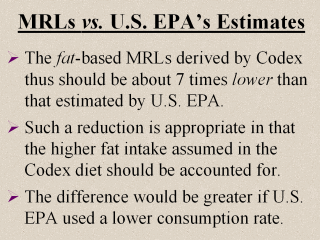 |
The consideration
presented in the last slide suggested that if both Codex and U.S. EPA were
to use the same RfD or ADI value in deriving a MRL (for the same health risk
prevention purpose), then the fat-based MRL derived by Codex should be about
7 times lower than U.S. EPA’s estimate. Here such a reduction is
deemed appropriate in that the higher fat intake assumed in the Codex diet
should be accounted for. If U.S. EPA’s default fish diet is lowered to 17.5
g/day, as for recreational fishers, then the tolerance limits used by
the two agencies could even be further apart, up to an additional 8-fold (i.e.,
up to 142.4 g/17.5 g -fold, again under the presumption that the fishers
would not additionally consume the 50 g of fat included in the Codex diet). |
